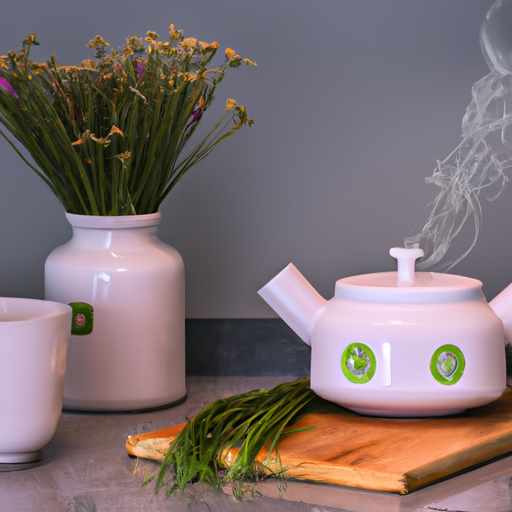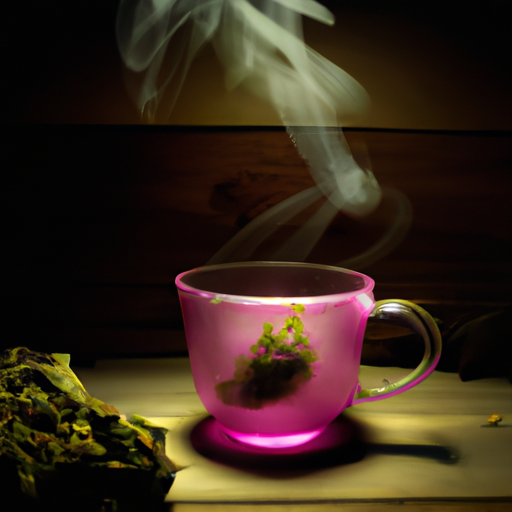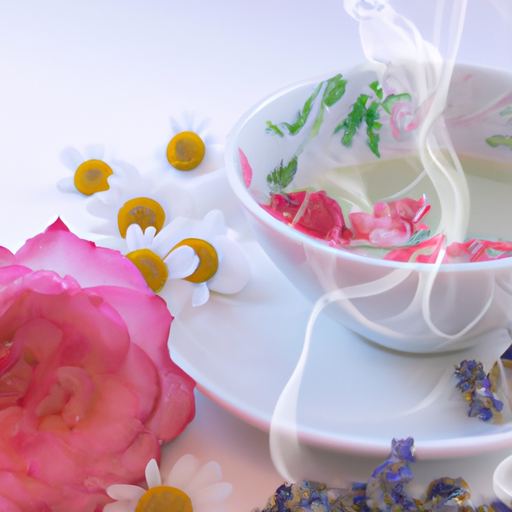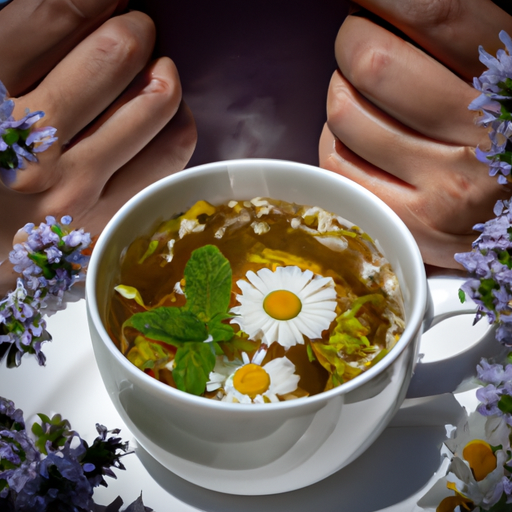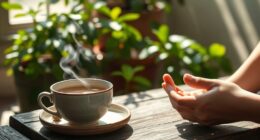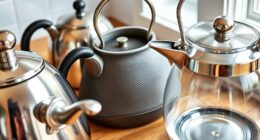Did you know that herbal tea has been enjoyed for centuries for its soothing and healing properties? It’s true! In fact, herbal tea is not only delicious but also has a wide range of health benefits.
If you’re like me and enjoy a warm cup of herbal tea to unwind after a long day or to boost your immune system, then you’re in for a treat. In this article, I will share with you everything you need to know about making herbal tea at home. From choosing the perfect blend to preparing the water and adding flavor enhancements, I’ll guide you through each step of the process.
So, grab your favorite mug and let’s get started on this delightful journey of brewing your own herbal tea. Trust me, once you experience the aroma and taste of a homemade herbal tea, you’ll never want to go back to store-bought tea bags again.
Key Takeaways
- Lemon and lime juice are tangy and rich in vitamin C and antioxidants, making them beneficial for health and digestion.
- Honey and agave syrup add sweetness to herbal tea and have various health benefits, such as soothing sore throats and boosting the immune system.
- Milk or non-dairy alternatives can enhance the creamy texture of herbal tea, with options like almond milk being low in calories and rich in vitamin E, and oat milk being high in fiber and beneficial for lowering cholesterol levels.
- Herbal tea provides antioxidant properties, boosts the immune system, aids in digestion, and promotes better sleep.
Choose Your Herbal Tea Blend
To choose your herbal tea blend, you’ll need to imagine a colorful array of dried flowers, leaves, and herbs, all waiting to be combined into a soothing and aromatic cup of tea.
Herbal tea offers numerous benefits, from boosting immunity to aiding digestion. But it’s not just about the health benefits; herbal tea is also a popular choice for relaxation. Chamomile, lavender, and lemon balm are known for their calming properties, while peppermint and ginger can help soothe an upset stomach.
Experiment with different blends to find the perfect combination that suits your taste and desired effect. Once you’ve chosen your herbal tea blend, it’s time to gather your ingredients and start brewing.
Gather Your Ingredients
First things first, gather up all your necessary ingredients to whip up a sensational cup of herbal tea. Here are the items you’ll need to get started:
-
Your favorite herbal tea blend: Choose a blend that suits your taste preferences and desired health benefits. Whether you enjoy chamomile for relaxation or peppermint for digestion, there’s a blend for everyone.
-
Fresh herbs or dried flowers: Enhance the flavor and aroma of your herbal tea by adding fresh herbs like lavender or dried flowers like rose petals.
-
Sweeteners: If you prefer a touch of sweetness, have honey, stevia, or agave syrup on hand.
-
Optional extras: Experiment with different brewing methods by adding lemon slices, ginger, or even a splash of coconut milk.
Now that you have all your ingredients ready, let’s move on to preparing your water for the perfect cup of herbal tea.
Prepare Your Water
To prepare your water for making herbal tea, it’s important to boil it to the right temperature. Different types of herbal teas require different water temperatures to achieve the best flavor and medicinal properties.
Additionally, the quality of the water you use can also make a difference in the final taste of your tea. Choosing between filtered water and tap water can impact the overall purity and taste of your herbal tea.
Boil Water to the Right Temperature
Get ready to enhance your herbal tea experience by bringing the water to the perfect temperature! Boiling techniques play a vital role in extracting the full flavor and benefits of herbal tea.
Different types of herbal teas require varying temperatures for optimal brewing. For delicate herbal teas like chamomile or green tea, a temperature of around 175°F to 185°F is ideal, while stronger herbal teas like black tea or mint can be brewed at a full rolling boil of 212°F.
Achieving the right water temperature can be easily done by using a kitchen thermometer or simply observing the water until it reaches the desired level of bubbling.
Once the water is heated to perfection, you can move on to the next step of deciding whether to use filtered water or tap water for your herbal tea brewing journey.
Filtered Water vs. Tap Water
Filtered water provides a purer and cleaner base for brewing your favorite herbal teas. Using filtered water has numerous benefits that can enhance your tea experience.
Firstly, filtered water removes impurities such as chlorine, lead, and bacteria, which can affect the taste and quality of your tea.
Secondly, it helps to eliminate any unpleasant odors or flavors that may be present in tap water.
Additionally, filtered water ensures that your tea is free from any potential contaminants, providing a healthier and safer beverage option.
Moreover, the absence of impurities allows the true flavors and aromas of the herbal tea to shine through, resulting in a more enjoyable and authentic taste experience.
Finally, using filtered water in your tea preparation demonstrates your commitment to quality and attention to detail.
Transitioning into the subsequent section, let’s now explore the next step in brewing your herbal tea.
Brew Your Herbal Tea
When it comes to brewing herbal tea, there are a couple of key points to keep in mind. First, steeping time and temperature are crucial for extracting the maximum flavor and benefits from the herbs. It’s important to follow the recommended steeping time provided on the tea packaging and to use water at the appropriate temperature for the specific type of tea.
Additionally, using a tea infuser or strainer is essential for preventing loose herbs from floating in your cup. This ensures a smooth and enjoyable tea-drinking experience.
Steeping Time and Temperature
To achieve the perfect cup of herbal tea, it’s crucial to steep it for the right amount of time and at the proper temperature. Steeping techniques play a significant role in enhancing the flavor and extracting the health benefits of the herbs.
Here are two sub-lists that will make you appreciate the art of steeping:
Steeping Time:
- Shorter steeping times, around 3-5 minutes, are ideal for delicate herbs like chamomile and peppermint.
- Stronger herbs like lavender and rosemary require longer steeping times, typically 8-10 minutes, to release their full flavor potential.
Temperature:
- For delicate herbs, use water that’s just below boiling point, around 180°F (82°C).
- Stronger herbs can handle hotter water, so aim for a temperature of around 200°F (93°C) to bring out their robust flavors.
By mastering the steeping time and temperature, you’ll unlock the true essence of your herbal tea.
Now, let’s move on to the next section and explore how to use a tea infuser or strainer for the perfect brew.
Use a Tea Infuser or Strainer
Immerse your senses in the world of herbal tea perfection by effortlessly using a tea infuser or strainer. When it comes to making herbal tea, using a tea infuser or strainer offers numerous benefits. Not only do they make the process easier, but they also ensure that your tea is free from loose leaves or debris.
A tea infuser is a small device made from mesh or perforated material that holds loose tea leaves while allowing water to flow through. It comes in various shapes and sizes, such as ball-shaped or basket-shaped infusers. On the other hand, tea strainers are usually made of metal or mesh and are placed over the cup to strain the tea as you pour. They are ideal for those who prefer loose tea in larger quantities.
Here’s a simple table to help you understand the different types of tea strainers:
| Type of Tea Strainer | Description |
|---|---|
| Ball Infuser | A small metal or mesh ball that holds loose tea leaves. |
| Basket Infuser | A larger infuser with a handle that can be placed in a teapot or cup. |
| Spoon Strainer | A spoon-shaped strainer with small holes to catch loose leaves. |
| Mesh Strainer | A fine mesh strainer that can be placed over the cup to catch any debris. |
Now that you know the benefits of using a tea infuser or strainer, let’s explore how you can add flavor enhancements to your herbal tea without compromising its natural goodness.
Add Flavor Enhancements
When it comes to adding flavor enhancements to my herbal tea, I like to experiment with different options. One of my favorites is adding a splash of lemon or lime juice, which adds a refreshing citrusy twist to the tea.
For a touch of sweetness, I often reach for honey or agave syrup, both of which complement the herbal flavors beautifully.
Lastly, when I’m in the mood for a creamy texture, I opt for adding a splash of milk or non-dairy alternatives like almond or coconut milk. These flavor enhancements can truly elevate the taste of my herbal tea and make the experience even more enjoyable.
Lemon or Lime Juice
Squeeze in some lemon or lime juice to add a burst of tanginess to your herbal tea. Not only does it enhance the flavor, but it also provides numerous benefits. Lemon juice is rich in vitamin C and antioxidants, which can boost your immune system and improve digestion. It also aids in detoxification and can help with weight loss.
If you don’t have any lemons on hand, you can use lime juice as a substitute. Lime juice has a similar tangy taste and offers similar health benefits.
Now, let’s move on to the next enhancement for your herbal tea: honey or agave syrup. These natural sweeteners will add a touch of sweetness to balance out the tanginess of the citrus juice.
Honey or Agave Syrup
To continue our exploration of herbal tea ingredients, let’s now discuss the sweeteners you can add to enhance the flavor. One popular option is honey, which not only adds a delightful sweetness but also boasts numerous health benefits. Rich in antioxidants and antibacterial properties, honey can aid in soothing sore throats and boosting the immune system.
Another alternative is agave syrup, derived from the agave plant. This natural sweetener has gained popularity due to its low glycemic index, making it a suitable choice for individuals with diabetes or those looking to manage their blood sugar levels. Additionally, agave syrup contains essential minerals like potassium and calcium.
So whether you prefer the classic taste of honey or the unique sweetness of agave syrup, these natural sweeteners will undoubtedly elevate your herbal tea experience.
Moving on to the next section, let’s explore the options of adding milk or non-dairy alternatives.
Milk or Non-Dairy Alternatives
If you want to enhance the creamy texture of your cup of herbal goodness, consider adding a splash of milk or a non-dairy alternative. Milk alternatives are a great option for those who’re lactose intolerant or following a vegan lifestyle.
There are various milk alternatives available, such as almond milk, soy milk, oat milk, and coconut milk, each bringing its own unique flavor and texture to your tea. These alternatives not only provide a creamy consistency but also offer their own set of health benefits.
For example, almond milk is low in calories and packed with vitamin E, while oat milk is rich in fiber and can help lower cholesterol levels. So, whether you prefer a nutty taste, a creamy texture, or a specific health benefit, milk alternatives can be a great addition to your herbal tea experience.
Now, let’s move on to the next section and learn how to serve and enjoy your cup of herbal tea.
Serve and Enjoy
Pour yourself a cup of herbal tea and let its soothing warmth embrace your senses, transporting you to a serene oasis of relaxation and tranquility. As you sip on this delightful beverage, not only will you be able to enjoy its delicious flavors, but you will also reap the numerous health benefits it offers. Herbal tea is known for its antioxidant properties and its ability to boost your immune system. It can also aid in digestion and promote better sleep. To enhance your serving experience, consider adding a slice of lemon or a drizzle of honey. Now, let’s move on to the next section where we will explore the storage and shelf life of herbal tea, ensuring that you can enjoy its benefits for a long time to come.
Storage and Shelf Life
When it comes to herbal tea, proper storage is key to maintaining its freshness and flavor. I always make sure to store my herbal teas in airtight containers, away from moisture, light, and heat. Additionally, it’s important to check for expiration dates on herbal tea products to ensure that they’re still safe to consume.
Properly Store Your Herbal Tea
To keep your herbal tea fresh and flavorful, it’s essential to store it properly. Here are some tips to properly store your herbal tea:
-
Use airtight containers: Seal your herbal tea in airtight containers to prevent exposure to air, moisture, and light. This helps retain its aroma and flavor.
-
Store in a cool, dark place: Keep your herbal tea away from heat and sunlight, as they can degrade its quality. Storing it in a cool, dark place like a pantry or cupboard is ideal.
-
Avoid strong odors: Herbal tea is absorbent and can easily take on surrounding odors. Keep it away from strong-smelling items like spices or coffee to maintain its original scent.
-
Don’t freeze it: Freezing herbal tea can cause moisture damage and affect its taste.
Properly storing your herbal tea ensures it stays fresh and maintains its beneficial properties. Now, let’s move on to the next section and learn about checking for expiration dates.
Check for Expiration Dates
Make sure to check the expiration dates on your herbal tea packaging to ensure you’re enjoying the freshest and most flavorful cup possible. Checking for quality and freshness is essential when it comes to herbal tea.
Even though herbal teas don’t usually spoil like other perishable foods, they can lose their potency and flavor over time. By checking the expiration dates, you can guarantee that you’re brewing a tea that is at its peak. Expired herbal teas may taste dull or stale, and their medicinal properties might be diminished. So, always take a quick look at the packaging before brewing your cup of herbal tea.
In the next section, we’ll delve into the exciting world of experimenting and customizing your herbal tea blends to suit your taste preferences.
Experiment and Customize
Get creative and personalize your herbal tea by experimenting with various combinations of herbs and spices. The beauty of herbal tea is that you can tailor it to your own taste preferences. By mixing different blends, you can create a unique and flavorful beverage that suits your individual palate. To help you get started, here is a table showcasing some popular herbs and spices commonly used in herbal tea:
| Herb/Spice | Flavor Profile | Health Benefits |
|---|---|---|
| Chamomile | Floral, light | Relaxation, sleep aid |
| Peppermint | Refreshing, minty | Digestion, headache relief |
| Ginger | Spicy, warming | Nausea relief, immune support |
Feel free to experiment with these ingredients and mix them together to find the perfect combination for your taste buds. Remember to have fun and enjoy the process of creating your own personalized herbal tea blends!
Frequently Asked Questions
How long does herbal tea stay fresh after brewing?
To store herbal tea and keep it fresh, I recommend transferring it to an airtight container and storing it in a cool, dark place. When reheating leftover tea, gently warm it on the stove or in the microwave.
Can I mix different herbal tea blends together?
Mixing different herbal tea blends can create unique flavor combinations and maximize the benefits of each tea. Experiment with recipes for relaxation or digestion by combining chamomile, peppermint, and ginger teas.
Are there any specific health benefits associated with herbal tea?
Different flavors of herbal tea offer unique health benefits. For example, chamomile promotes relaxation, peppermint aids digestion, and ginger boosts immunity. Herbal tea is known for its role in reducing stress and promoting overall well-being.
Can I use dried herbs from my garden to make herbal tea?
Yes, I can use dried herbs from my garden to make herbal tea. Using fresh herbs for herbal tea has many benefits, such as preserving their natural flavors and aromas, and ensuring a longer shelf life.
What are some common mistakes to avoid when brewing herbal tea?
When it comes to brewing herbal tea, common mistakes can be like adding too much or too little tea leaves, using boiling water, or steeping for too long. Proper brewing techniques ensure a perfect cup every time.
Conclusion
In conclusion, making herbal tea is a delightful and soul-soothing experience. With a dash of creativity and a pinch of knowledge, you can create your own personalized blends that dance on your taste buds.
So go forth, my tea-loving friend, and let your imagination run wild. Blend and brew, savor and sip. As you explore the world of herbal teas, remember to take a moment to appreciate the calming aroma and delicate flavors that nature has to offer.
Cheers to a cuppa that nourishes both body and spirit!

